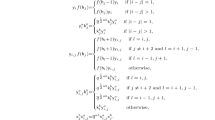Abstract
Let \( \mathfrak{g} \) be a complex semisimple Lie algebra. Although the quantum group \( {U}_{\hslash \mathfrak{g}} \) is known to be isomorphic, as an algebra, to the undeformed enveloping algebra \( U\mathfrak{g}\left\llbracket \hslash \right\rrbracket \), no such isomorphism is known when \( \mathfrak{g}\ne \mathfrak{s}{\mathfrak{l}}_2 \). In this paper, we construct an explicit isomorphism for \( \mathfrak{g}=\mathfrak{s}{\mathfrak{l}}_n \), for every n ≥ 2, which preserves the standard flag of type A. We conjecture that this isomorphism quantizes the Poisson diffeomorphism of Alekseev and Meinrenken [2].
Similar content being viewed by others
References
A. Yu. Alekseev, On Poisson actions of compact Lie groups on symplectic manifolds, J. Differential Geom. 45 (1997), no. 2, 241–256.
A. Yu. Alekseev, E. Meinrenken, Ginzburg–Weinstein via Gelfand–Zeitlin, J. Differential Geom. 76 (2007), no. 1, 1–34.
A. Yu. Alekseev, E. Meinrenken, Linearization of Poisson–Lie group structures, J. Symplectic Geom. 14 (2016), no. 1, 227–267.
A. Appel, S. Gautam, Quantization of Alekseev–Meinrenken diffeomorphism, in preparation.
A. Appel, V. Toledano Laredo, Monodromy of the Casimir connection of a symmetrisable Kac–Moody algebra, arXiv:1512.03041 (2015).
A. Appel, V. Toledano Laredo, Uniqueness of Coxeter structures on Kac–Moody algebras, Adv. Math. 347 (2019), 1–104.
P. P. Boalch, Stokes matrices, Poisson Lie groups and Frobenius manifolds, Invent. Math. 146 (2001), no. 3, 479–506.
J. Brundan, A. Kleshchev, Parabolic presentations of the Yangian Y (\( \mathfrak{g}{\mathfrak{l}}_n \)), Comm. Math. Phys. 254 (2005), 191–220.
V. Chari, A. Pressley, A Guide to Quantum Groups, Cambridge University Press, Cambridge, 1994.
J. Dixmier, Enveloping Algebras, Graduate Studies in Mathematics, Vol. 11, American Mathematical Society, Providence, RI, 1996.
A. De Sole, V. G. Kac, D. Valeri, A Lax type operator for quantum finite W-algebras, Selecta Math. (N.S.) 24 (2018), no. 5, 4617–4657.
В. Г. Дринфельд, Алгебры Хопфа и квантовое уравнение Янга–Бакстера, ДАН СССР 283 (1985), no. 5, 1060–1064. Engl. transl.: V. G. Drinfeld, Hopf algebras and the quantum Yang–Baxter equation, Soviet Math. Dokl. 32 (1985), no. 1, 254–258.
V. G. Drinfeld, Quantum groups, in: Proceedings of the I.C.M., Vol. 1, 2 (Berkeley, Calif., 1986), Amer. Math. Soc., Providence, RI, 1987, pp. 798–820.
В. Г. Дринфельд, Новая реализация янгианов и квантовых аффинных алгебр, ДАН СССР 296 (1987), no. 1, 13–17. Engl. transl.: V. G. Drinfeld, A new realization of Yangians and quantum affine algebras, Soviet Math. Dokl. 36 (1988), no. 2, 212–216.
В. Г. Дринфельд, О почти коммутативных алгебрах Хопфа, Алгебр и анализ 1 (1989), вьш. 2, 30–46. Engl. transl.: V. G. Drinfeld, On almost cocommutative Hopf algebras, Leningrad Math. J. 1 (1990), no. 2, 321–342.
B. Enriquez, P. Etingof, I. Marshall, Comparison of Poisson structures and Poisson–Lie dynamical r-matrices, Int. Math. Res. Not. (2005), no. 36, 2183–2198.
S. Gautam, V. Toledano Laredo, Yangians and quantum loop algebras, Selecta Math. (N.S.) 19 (2013), no. 2, 271–336.
S. Gautam, V. Toledano Laredo, Yangians, quantum loop algebras, and abelian difference equations, J. Amer. Math. Soc. 29 (2016), no. 3, 775–824.
F. Gavarini, The quantum duality principle, Ann. Inst. Fourier (Grenoble) 52 (2002), no. 3, 809–834.
V. L. Ginzburg, A. Weinstein, Lie–Poisson structure on some Poisson Lie groups, J. Amer. Math. Soc. 5 (1992), no. 2, 445–453.
M. Jimbo, A q-difference analogue of U(\( \mathfrak{g} \)) and the Yang–Baxter equation, Lett. Math. Phys. 10 (1985), no. 1, 63–69.
M. Jimbo, Quantum R–matrix for the generalized Toda system, Comm. Math. Phys. 102 (1986), 537–547.
S. Z. Levendorskii, On generators and defining relations of Yangians, J. Geometry and Physics 12 (1992), 1–11.
A. Molev, Yangians and Classical Lie Algebras, Mathematical Surveys and Monographs, Vol. 143, American Mathematical Society, Providence, RI, 2007.
M. Nazarov, V. Tarasov, Representations of Yangians with Gelfand–Zetlin bases, J. Reine Angew. Math. 496 (1998), 181–212.
V. Toledano Laredo, A Kohno–Drinfeld theorem for quantum Weyl groups, Duke Math. J. 112 (2002), no. 3, 421–451.
V. Toledano Laredo, Quasi–Coxeter algebras, Dynkin diagram cohomology and quantum Weyl groups, Int. Math. Res. Pap. 2008 (2008), Art. ID rpn009, 167 pp.
Author information
Authors and Affiliations
Corresponding author
Additional information
Publisher’s Note
Springer Nature remains neutral with regard to jurisdictional claims in published maps and institutional affiliations.
Rights and permissions
About this article
Cite this article
APPEL, A., GAUTAM, S. AN EXPLICIT ISOMORPHISM BETWEEN QUANTUM AND CLASSICAL \( \mathfrak{s}{\mathfrak{l}}_n \). Transformation Groups 25, 945–980 (2020). https://doi.org/10.1007/s00031-019-09543-6
Published:
Issue Date:
DOI: https://doi.org/10.1007/s00031-019-09543-6



